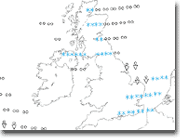The CFS model is different to any other operational weather forecasting model you will see on Weatheronline.
Developed at the Environmental Modelling Center at NCEP (National Centers for Environment Prediction) in the USA,
the CFS became operational in August 2004.
The systems works by taking reanalysis data (NCEP Reanalysis 2) and ocean conditions from GODAS
(Global Ocean data Assimilation). Both of these data sets are for the previous day, and so you
should be aware that before initialisation the data is already one day old.
Four runs of the model are then made, each with slightly differing starting conditions, and from
these a prediction is made.
Caution should be employed when using the forecasts made by the CFS. However, it is useful when
monitored daily in assessing forecasts for the coming months, the confidence levels in these
forecasts and in an assessment of how such long range models perform.
A description of the CFS is given in the following manuscript.
S. Saha, S. Nadiga, C. Thiaw, J. Wang, W. Wang, Q. Zhang, H. M. van den Dool, H.-L. Pan, S. Moorthi, D. Behringer, D. Stokes, M. Pena, S. Lord, G. White, W. Ebisuzaki, P. Peng, P. Xie , 2006 : The NCEP Climate Forecast System. Journal of Climate, Vol. 19, No. 15, pages 3483.3517.
http://cfs.ncep.noaa.gov/






















